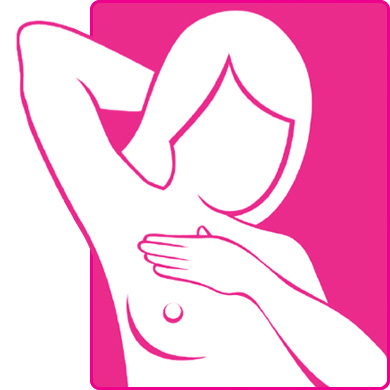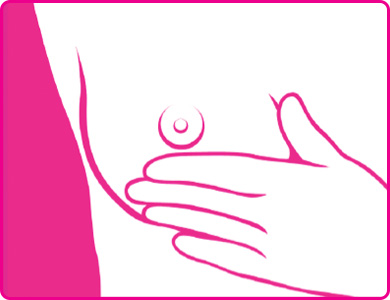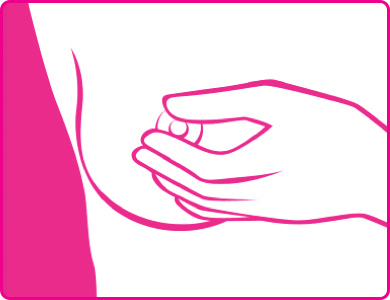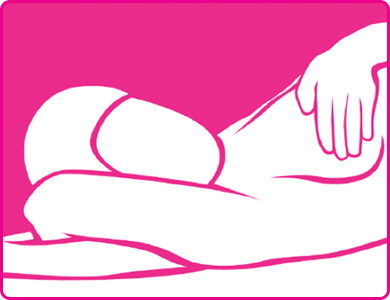Simple steps to Check Yourself
You spend a lot of time checking. You check your text messages, emails and social media status updates. You check the weather, sports scores and TV listings. You check your stock prices and bank account balance, the gas level in your car, your outfit, hair and makeup.
Now, Check Yourself!
Breast Self-Exam
Early detection is your best protection. Do Breast Self-exam! Read below or download the PDF to learn how to check yourself.
In the Shower
Put your right hand behind your head.

 Press your fingers firmly on your right breast and feel for any lump or thickening.
Press your fingers firmly on your right breast and feel for any lump or thickening.
Repeat the procedure in your other breast.In front of a mirror
Take note of any irregularity in your breasts’ appearance such as puckering, dimpling, or scaling by clasping your hands behind your head.


Afterwards, gently squeeze your nipples and check for any discharge.

While lying down

Place a pillow under your right shoulder. Put your right hand firmly on your right breast.
In circular motion feel for any unusual lump or mass.
Check also the area between your breast and armpit.
Repeat the procedure on your left breast.
Get Screened
Understand the Risks You Share with Other Women
It probably comes as no surprise that being a woman is the greatest risk factor associated with breast cancer. Yes, men can get breast cancer, but they account for only 1% of cases diagnosed annually. Other general risk factors relate to age and certain ethnic backgrounds.
Know Your Own Risk Factors
Your personal breast cancer risk is based on many specific factors. Some are biological, others are lifestyle related and can be managed. Knowing your own unique set of risk factors is a critical step of Check Yourself and of being proactive when it comes to your breast health.
Take Actions to Lower Your Risk
Many breast cancer factors are in your control, including those related to diet, alcohol and hormone replacement use, tobacco consumption and exposure to certain environmental elements. Learn about the important steps you can take to improve your health and lower your risk for breast cancer.
Use Screening Strategies Most Appropriate for Your Risk Level
Confused by screening guidelines and media headlines? You're not alone. That's why it's so important to know your risk factors and your body. Armed with this information, a doctor can help you to determine when to start screening, how often to screen and what screening tests to use.
Understanding the Risks, Potential Harms and Overall Value of Pursuing Early Detection
Experts generally agree that the earlier a breast cancer is found, the better the chances for a positive outcome. Yet, the diagnostic tools and screening processes are not perfect.
Learn How Biopsies Help Confirm a Diagnosis
After an initial screening, a doctor may suggest a breast biopsy, where a small piece of tissue is extracted for testing. There are a number of different types of biopsies. Check out our comparison chart for a description of each procedure, accuracy rates, the use of stitches, scars and future mammograms, the use of anesthesia and recovery.
Understand Your Options after a Breast Cancer Diagnosis
The period following a breast cancer diagnosis is about education, options and decisions. You need to partner with your doctor and learn as much as possible about your type of breast cancer, specific telltale “markers” and treatment options.
Take Action for Your Best Possible Outcome, Physically and Emotionally
Many types of support are available to you. Learn about resources to help you face daily challenges related to work, family care, even transportation to medical appointments, as well as options for counseling and financial assistance.
Disclaimer: This page was created for educational purposes only and should not be interpreted as medical advice. Be sure to partner with your medical provider to develop the best personal care plan for you. Adapted from the American Cancer Society, 2013-2014 Breast Cancer Facts & Figures.